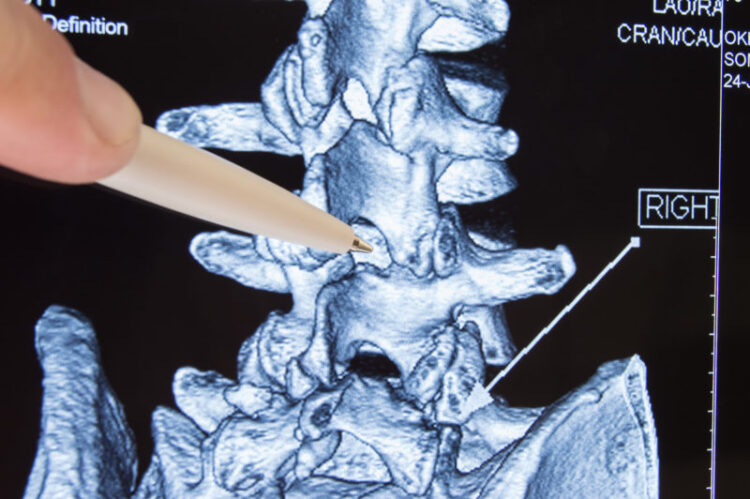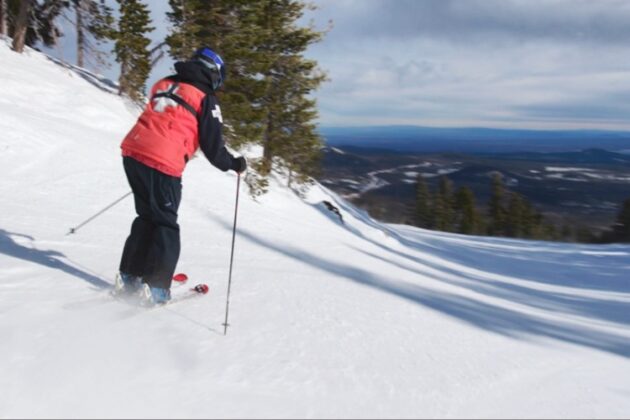
Back pain is mostly caused by an activity resulting in sharp pain in your lower back or a lack of activity causing stiff, unused muscles that are unable to keep up with daily demands. Although these spine conditions can be very painful, many people recover after a few weeks or months of nonsurgical treatment.
Spine Anatomy
The spine is comprised of small bones called vertebrae. These are stacked on top of each other and form the natural curves in your spine. The vertebrae provide a protective layer for the spinal cord and nerves. Between each set of vertebrae there are small, round discs that act as a cushion between the vertebrae. Each disc has a jelly-like center (nucleus) that is surrounded by a tough outer ring (annulus).
COMMON CAUSES OF BACK PAIN
Herniated Discs
When a disc herniates, the nucleus pushes against the outer ring (annulus) and puts pressure on the sensitive spinal nerves, causing back pain, numbness, tingling, and/or weakness. If this occurs in the low back (lumbar spine), it can put pressure on the nerve root leading to pain in the buttocks, legs, and feet. This is called sciatica. Although less common, herniated discs can also occur in the upper spine (thoracic spine) or neck (cervical spine). When they occur in the neck, it can cause symptoms in the shoulders, arms, and hands.
Herniated discs, also known as slipped discs or ruptured discs, are a very common spine injury. Sudden injuries usually occur with lifting, pulling, bending, or twisting movements. They can also occur from age-related weakening of the spinal discs. As people age, the discs gradually deteriorate. There is less water content so they shrink, and the spaces between the vertebrae get narrower, which increases the likelihood of a herniated disc.
Bulging Discs
The main difference between a herniated disc and a bulging disc is that the nucleus does not push out of the annulus in a bulging disc. The disc simply bulges out of the space it normally occupies in the spine. Considered a normal part of aging, a bulging disc may not even cause any symptoms. If it bulges enough to press on spinal nerves or narrow the spinal canal, it can lead to symptoms including pain, numbness, tingling, or weakness. A bulging disc can sometimes be a precursor to a herniated disc.
In this pre-recorded webinar physiatrist, Mathew Paluck and neurosurgeon, Dr. Raymond Tien will discuss both conservative and surgical treatment options for chronic back pain.
TREATMENT FOR BACK PAIN
To determine the cause of your back pain, your neurosurgeon will conduct a physical exam and order imaging tests, such as x-ray and MRI. Initially, these common disc conditions are typically treated with nonsurgical methods.
NONSURGICAL TREATMENT
There are a wide array of non-surgical treatment solutions to help people experiencing back pain or injury get back to what they love. Injections are commonly used to treat back pain when conservative methods, such as rest, ice, anti-inflammatory medication, or physical therapy have not alleviated symptoms. They are effective because they deliver treatment directly to the source of the pain.
Epidural steroid injections reduce inflammation and relieve back pain caused by spinal nerve irritation from herniated discs and spinal stenosis. In this procedure, the physician injects an anti-inflammatory steroid into the painful area of the spine where the spinal nerves are located, which decreases swelling and relieves pressure. This is typically performed using x-ray guidance, known as fluoroscopy, to properly guide the needle.
The facet joints are found on both sides of the back of the spine. They can become irritated and cause back pain due to arthritis or a back injury. Facet joint injections can relieve back pain immediately because an anesthetic is first injected into the facet joint under x-ray guidance. This also helps the physician diagnose the source of the pain. A steroid is then injected to provide long-term pain relief. Radiofrequency Ablation is also commonly used to treat inflamed facet joints that cause back pain. The physician uses x-ray guidance to direct a special type of needle to the medial branch nerves that innervate the facet joints. Electrical current is passed through the needle to heat the medial branch nerve and create a lesion that disrupts the pain signal from the joint.
A trigger point injection is used to treat back pain when the muscles do not relax and tighten into a knot or spasm called a trigger point. A trigger point may also cause pain or irritate nerves to cause pain in a different part of the body. In this procedure, an anesthetic is injected into the trigger point to relax the muscles and alleviate pain.
Injections typically take place in an outpatient surgery center so patients can go home the same day after receiving an injection. The most common side effect is soreness or redness around the injection area. After the local anesthetic wears off, the patient may still feel pain for several days while the steroid medication begins to take effect. Each injection has risks and benefits that you should discuss with your doctor if you have chronic back pain.
SURGICAL TREATMENT
If conservative treatment methods do not work, your neurosurgeon may recommend lumbar microdiscectomy, one of the most common surgeries to alleviate back pain from herniated or bulging disks. It involves removing the herniated part of the disc and any fragments that are putting pressure on the spinal nerve. This is an outpatient procedure, meaning you go home the same day, rather than staying in the hospital overnight.
After surgery, patients will start physical therapy and learn exercises to strengthen their core. It’s a minimum three-month recovery before you can resume activities. With a herniated disc, you have a hole in the annulus and it will never be as strong as it was originally. You need to give it time to heal and don’t want to add stress to it too quickly.
PREVENTING BACK PAIN
Exercise and stretch
There are a number of benefits to exercising and stretching on a regular basis. A body in motion stays in motion, and implementing a daily routine focused on a complete body workout can help build important muscle that will help support different areas of your body, such as your back. For this particular area, combine exercise, like walking, with specific exercises to keep the core muscles in your back and abdomen strong and flexible. Strengthening your core muscles will help support your spine and can help prevent back pain.
Stretching is just as important as exercising. It also feels REALLY good, and the best part of all is that stretching requires no equipment and can be done any time, any place. Here are a few stretches to get you started.
- Head rolls: This stretch supports the cervical spine and trapezius. You should feel this stretch all around your neck and into your upper back.
- Kneeling back extension: Start by kneeling with your arms crossed over your chest or arms straight up towards the ceiling. From this position, you will start hinging at the hips, pushing your butt back towards your heels, and chest forward maintaining a neutral spine. Lower as far as you can until you cannot keep a neutral spine. This stretch should be felt in your lower back and your abdominals. Click hereto watch a video demonstration.
- Sitting rotation stretch: A stretch that when done properly, will be felt in your buttocks, as well as your sides.
- Modified seat side straddle: You should feel this stretch in the back of your thighs and into your lower and middle back.
- Bird Dogs: Start on your hands and knees with your hands directly under your shoulders and your knees directly under your hips. Keep your back straight and your ab muscles tight. Lift your right leg, extend it straight behind you, and hold for five seconds before lowering it down. Repeat on the other side.
- Knee to chest: Start on your back and gently bring your right knee to your chest. Hold it for 15 to 30 seconds before lowering it back down. Repeat with the left leg.
For examples of these stretches and for more strength and conditioning ideas, we love this Spine Conditioning Program created by OrthoInfo.
Weight Loss
Some people suffer from back pain because of an unhealthy body weight. Back pain may be reduced by lowering body weight to decrease the stress and pressure it is placing on the lower back and spine.
Avoid Smoking
When we think about smoking and the ill effects it has on our health, we don’t often think about the harm it causes to every tissue in the human body. Both smoke and nicotine can cause the flexible discs that lie in between the vertebrae in your spine to degenerate or wear out faster than normal.
Proper Lifting
There is a right and wrong way to lift items. Even lifting the smallest, lightest object can cause damage to our lower back if proper form is compromised. How you lift items has a direct impact on your spine health.
Guidelines for proper lifting:
- Take some time to determine your plan for lifting and do not rush.
- Position yourself close to the object you want to lift.
- Stand with your feet shoulder-width apart to give yourself a solid base of support.
- Bend at the knees.
- Tighten your stomach muscles.
- Lift with your leg muscles as you stand up.
- If an object is too heavy or is an awkward shape, do not try to lift it by yourself. Get help.
Supporting you back while sitting
The majority of us do our fair share of sitting. Whether it be for our jobs or for leisure, there is a proper way to sit that will be the most beneficial for your spine and back.
- When sitting, keep your back in a normal, slightly arched position.
- Make sure your chair supports your lower back.
- Keep your head and shoulders erect.
- Make sure your working surface is at the proper height so you don’t have to lean forward.
- Once an hour, if possible, stand and stretch. Place your hands on your lower back and gently arch backward.
If your back pain persists or you would like to determine the cause of your pain, contact one of our orthopedic doctors for an evaluation.





